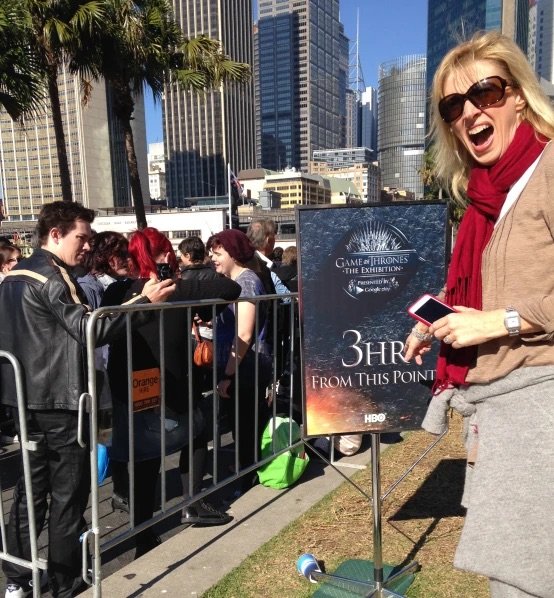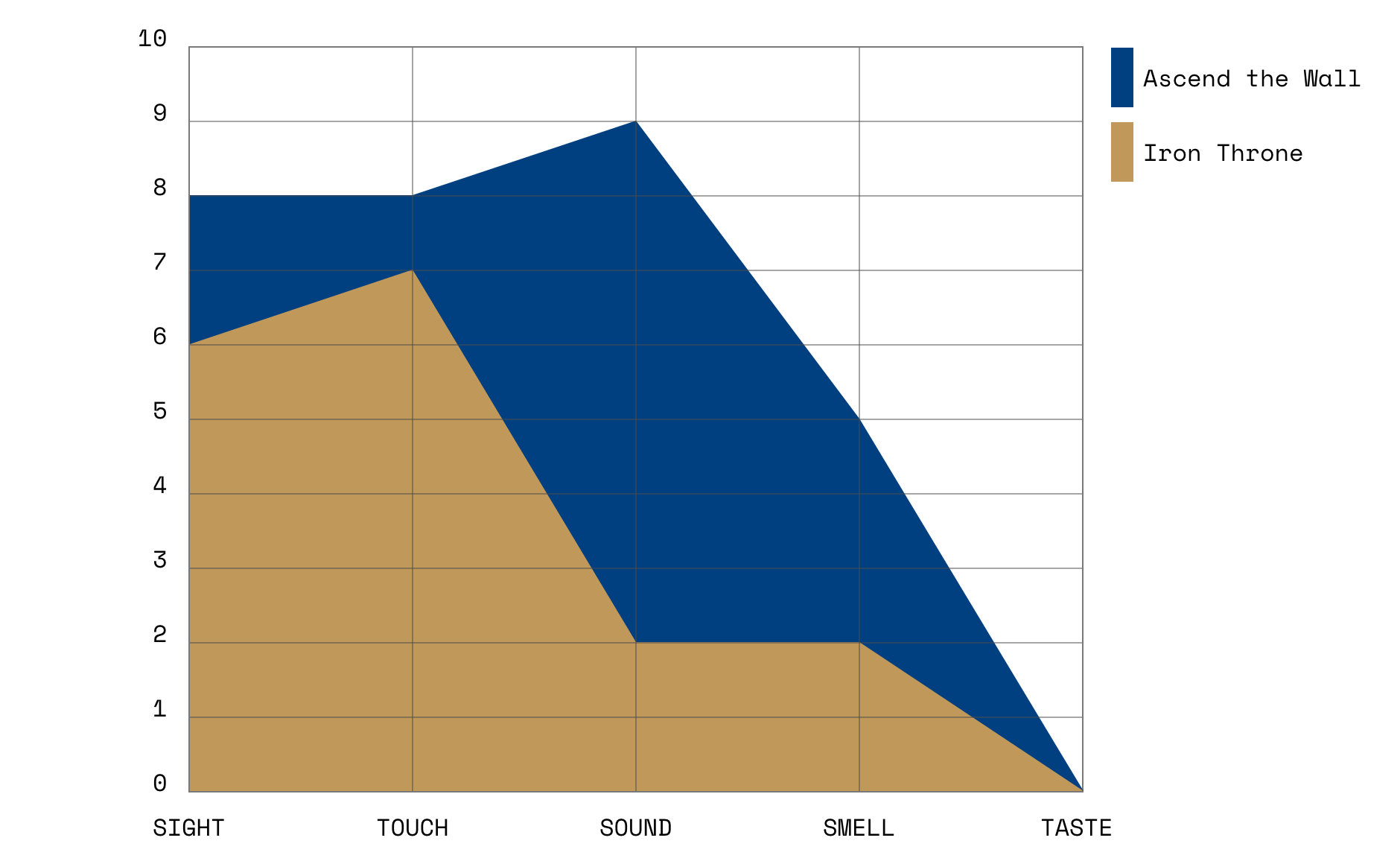ascend the wall
hbo Game of thrones, 2013 | virtual realityGame of Thrones was growing in popularity, and its globe–hopping exhibition drew thousands of fans and international press coverage.
Authentic costumes and memorabilia were featured, including the Iron Throne, a central artifact to the show and a major draw for the Instagram generation. Fans were waiting more than three hours for the photo opportunity.
HBO had found itself with the catch-22 of success: after setting expectations so high, continuing to delight and awe the fan base felt insurmountable. The potential fallout for not delivering a worthy attraction would now be much worse. Not only did we have to worry about reigniting the fan base, but also we had to avoid a social media tongue-lashing.
A woman expressing shock at the 3 hour wait time to get into the traveling Game of Thrones Exhibition.
DISCLAIMERSome information has been redacted and obfuscated in this case study to comply with my non-disclosure agreement. Opinions and analyses in this case study are my own and do not necessarily reflect the views of my past employers.
tl;drI helped develop the early-stage storyboarding, operations strategy, and immersive design thinking for the Game of Thrones Ascend the Wall VR experience.
AGENCyRelevent
Framestore VR Studio
TeamIan Cleary, VP Innovation
Len Yeh, UX Design
DiscoveryThe “Curse of the Sequel” is notorious in the film industry. Successful movies create a demand for more, but studios are caught in a bind. What they delivered is no longer fresh; the creators implicitly deprecated themselves.
Designing events has some parallels, and the analogy is interesting to examine.
Sequels often fail because they promise “bigger and better,” but deliver familiar experiences.
Reductive approaches of throwing money at a good thing doesn’t automatically result in a better thing.
One-upmanship can feel thoughtless and futile. After Felix Baumgartner jumped from the edge of space and broke the sound barrier in free fall (Red Bull Stratos), has anyone cared about any Red Bull stunt since? The stunts just seem to try to outdo each other’s risk factor.
InsightGreat sequels seem to try new formulas and deliver fresh perspectives while retaining some core elements for familiarity. The Avengers movie felt original as we had never seen our solo heroes challenged to work with teammates. However, their personalities and interactions felt true to the characters.
To apply this concept to experiential design, we needed a rubric to evaluate past Game of Thrones exhibitions and provide a framework for our new ideas.
We referenced the 5-Sense Design Theory by Jinsop Lee, an industrial designer who spoke about designing multi-sensory experiences in a TED Talk. He uses a 5 Senses Graph to evaluate games, extreme sports, and even sex. Encounters that deliver highly on more facets seem to correlate with higher enjoyment.
Evaluating past Game of Thrones exhibitions, we knew that most elements were for the eyes only. The Iron Throne was an exception — something to see and feel as you pretended to be king/queen for a minute. People seem to have an instinctual understanding of that as it became the most exciting artifact.
5 Senses Graph - Irone Throne vs. the rest of the exhibition. I argue that a real Iron Throne delivers on sound and smell as well. However subtly it may be, it's still more than what I would get from a video. I can hear my touch or my clothes scraping against the prop. I can smell the space, however much it may blend into the background.
Game of Thrones takes place in the fantasy world of Westeros; it is literally inaccessible. But what if we could make it more accessible like the Iron Throne? What if we could use technology to dial up the scores on a wider range of senses? Could we package that into a compelling story to show fans something new about a familiar world?
CONCEPTstart with the compelling story
Storyboarding various plot lines led us to a journey resembling that of Jon Snow, a soldier stationed at “the Wall.” The location is a Great-Wall-of-China-on-steroids, built to keep out foreign enemies and ripe with fun, environmental elements to simulate. Soldiers brave arctic conditions in a dilapidated fort with a feeble elevator struggling up 700 feet high. It is cold, windy, and shaky as hell.
bringing the world to life
Framestore VR Studio was our partner who rendered an accurate world in Unity for Oculus Rift. Our fabrication teams went to work orchestrating wind machines, CO2 jets with sub-zero air, and rumbling platforms — anything to make our virtual experience feel much more realistic.
5 Senses Graph - Ascend the Wall vs Irone Throne. We didn't just dial up the sight and touch aspects, but also widened the scope to truly tackle sound (and arguably smell).
Concurrently, we strategized around building anticipation. A known problem with VR is that it's hidden; those wearing headsets are immersed, but it’s silly for anyone else watching. It's underwhelming and kills the enthusiasm.
This made us realize that the space for fans to try the experience needed to be wrapped in a “cage.” We could create high-production elevators that made it look like an attraction “ride.” All the fans’ reactions — laughs, screams, and gasps — would be on display for those in the queue to live vicariously.
A snippet of some early-stage storyboards and operations planning.
↲
DesignAscend the Wall VR: View from the top of the Wall
story & Interaction
Starting at 1:13 in this video, you can get a great sense of what the experience was like.
the Elevator components
Ian Cleary (VP Innovation), my partner on this project, explained the design of simulating the moving elevator and environmental elements to press outlets like Wired.
"What we're trying to do with all of this is trick your brain," says Cleary. "You've got visual signals going to your brain, a 3D soundscape, and then the tactile elements like wind and shaking. Your brain is getting three or four major inputs that are telling you that you're not in a concert hall in Austin, Texas. You're riding up an elevator at Castle Black in Westeros."
Photos from the exhibition
Video of Irish YouTuber Clisare's live reaction to the elevator experience
Press and reviewsOne of these guys is basically you in the experience. I won't tell you which.
↲
We asked [Relevent Agency] to present some concepts. This one overshadowed all of the other ones.
⬆︎ Elana Loewenthal, HBO director of international marketing (THE NEXT WEB)Though I had fallen to my untimely death after being impaled with a flaming arrow, I felt like I had won by just experiencing the rush.
⬆︎ Greg seals, writer @ Daily DotReflectionsTo be part of a project that received such a large amount of publicity was a ride in and of itself. The success was large enough to influence HBO’s future VR endeavors in building out worlds of their properties.
While I didn’t have the pleasure to stay on the project through production, the research, strategy, and concepting phases forced me to interrogate what makes experiences fun for people. It taught me the importance of story in elevating any experience. I didn’t foresee this at the time, but the lessons I learned then eventually influenced my approach to designing UI and educational games for kids.





